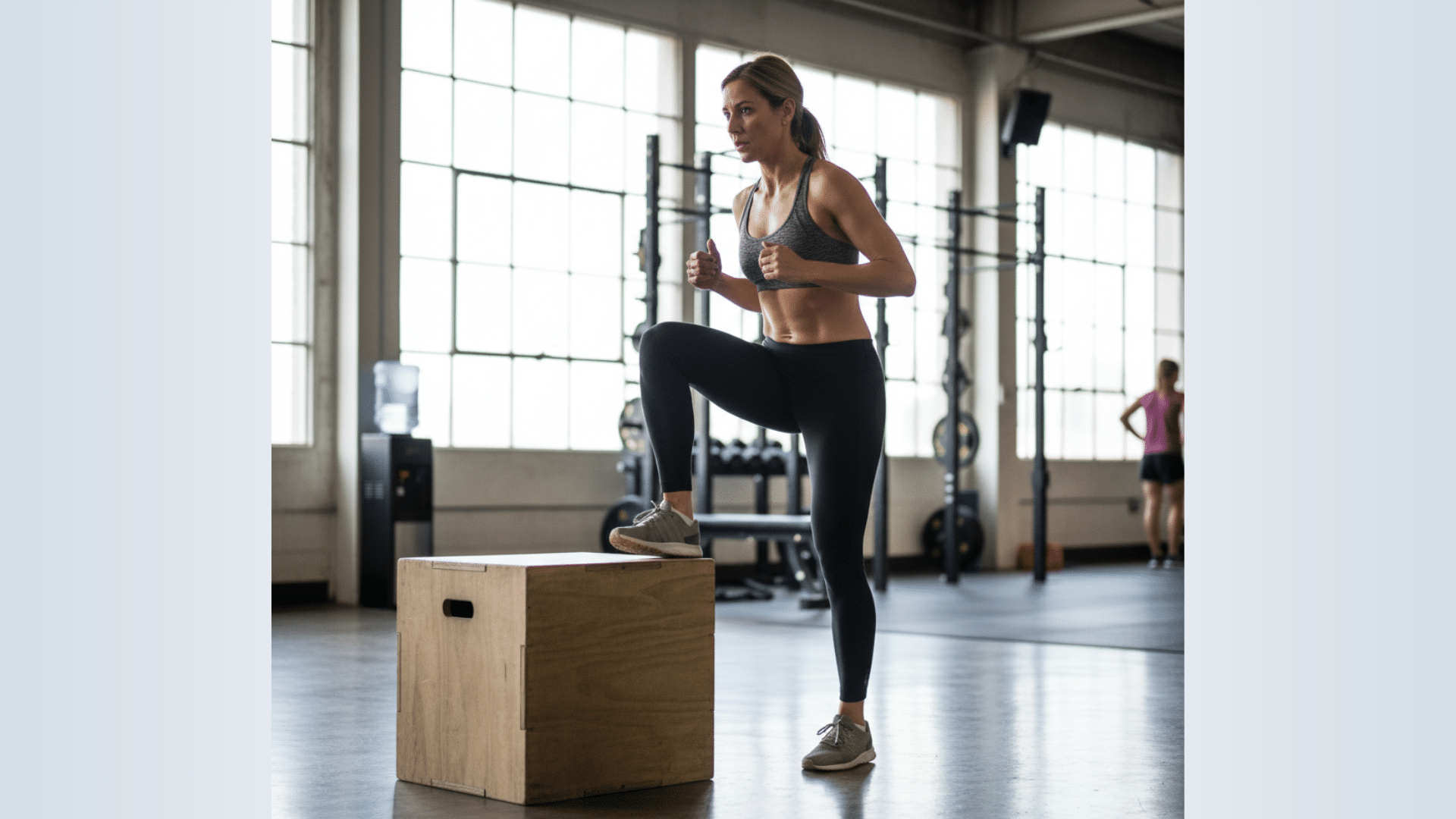I know how frustrating it feels when your knees ache or your legs give out on tough workouts.
That’s why I started adding eccentric quad exercises to my own routine, and the difference has been huge. These moves focus on the lowering phase, where your quads control the descent, giving you strength, balance, and joint support.
In this post, I’ll share the best eccentric quad exercises you can try, along with tips for programming, progressions, and avoiding common mistakes.
If you want stronger, more stable legs that can handle daily life, sports, or recovery, this guide is for you.
What are Eccentric Quad Exercises?
Eccentric quad exercises focus on the lowering phase of movement, where your quadriceps lengthen while under control. Instead of pushing upward, the emphasis is on slowing the descent.
For example, lowering into a squat or stepping down from a box requires the quads to resist gravity and manage the body’s weight. This type of training is different from simply lifting because it builds strength in the lengthened position, which supports stability and joint health.
Athletes, rehab patients, and casual exercisers all benefit from this method, making it a versatile approach to improving quad function and reducing injury risks.
Benefits of Eccentric Quad Training

Training the quads with slow, controlled lowering movements has unique advantages. Here are some key benefits you can expect from adding eccentric quad work to your routine:
Rehab and Injury Prevention
Eccentric quad exercises are widely used in rehabilitation because they reduce stress on the knees while improving strength. By training the muscles during the lowering phase, you strengthen tendons and ligaments that stabilize the joint.
This method helps prevent recurring pain and reduces the risk of injuries, such as patellar tendonitis. It’s especially helpful for people recovering from knee surgery or managing long-term knee issues.
Building Strength and Endurance
Training eccentrically forces the quadriceps to handle greater loads than traditional lifting. This builds deeper muscle strength while also improving endurance. Since the lowering phase lasts longer, the muscles experience more time under tension, which contributes to growth and resilience.
Athletes, gym-goers, and active individuals can utilize this approach to prepare their legs for intense workouts, extended activity sessions, or demanding physical tasks such as sports or hiking.
Improving Balance and Motor Control
Controlling movement while lowering teaches your body better stability and coordination. This type of training enhances motor control, which is essential for daily activities such as climbing stairs, stepping off curbs, or carrying loads.
It also benefits athletes who need precise control during landings or changes of direction. Practicing eccentric quad exercises helps reduce wobbling, improves balance, and ensures that your joints stay supported throughout a range of movements.
Performance Boost for Runners and Athletes
Runners, especially those training for downhill routes, gain a major advantage from eccentric quad exercises. The controlled lengthening action strengthens the legs to absorb impact and resist fatigue during long distances.
Athletes in sports that involve jumping, sprinting, or sudden stops also benefit from the added stability and resilience. Stronger eccentric control leads to better performance on the field, track, or trail, while also reducing the likelihood of overuse injuries.
Best Eccentric Quad Exercises
Focusing on the lowering phase of movement targets your quads in a powerful way. Here are some of the most effective eccentric quad exercises to build strength and control:
1. Step-Down
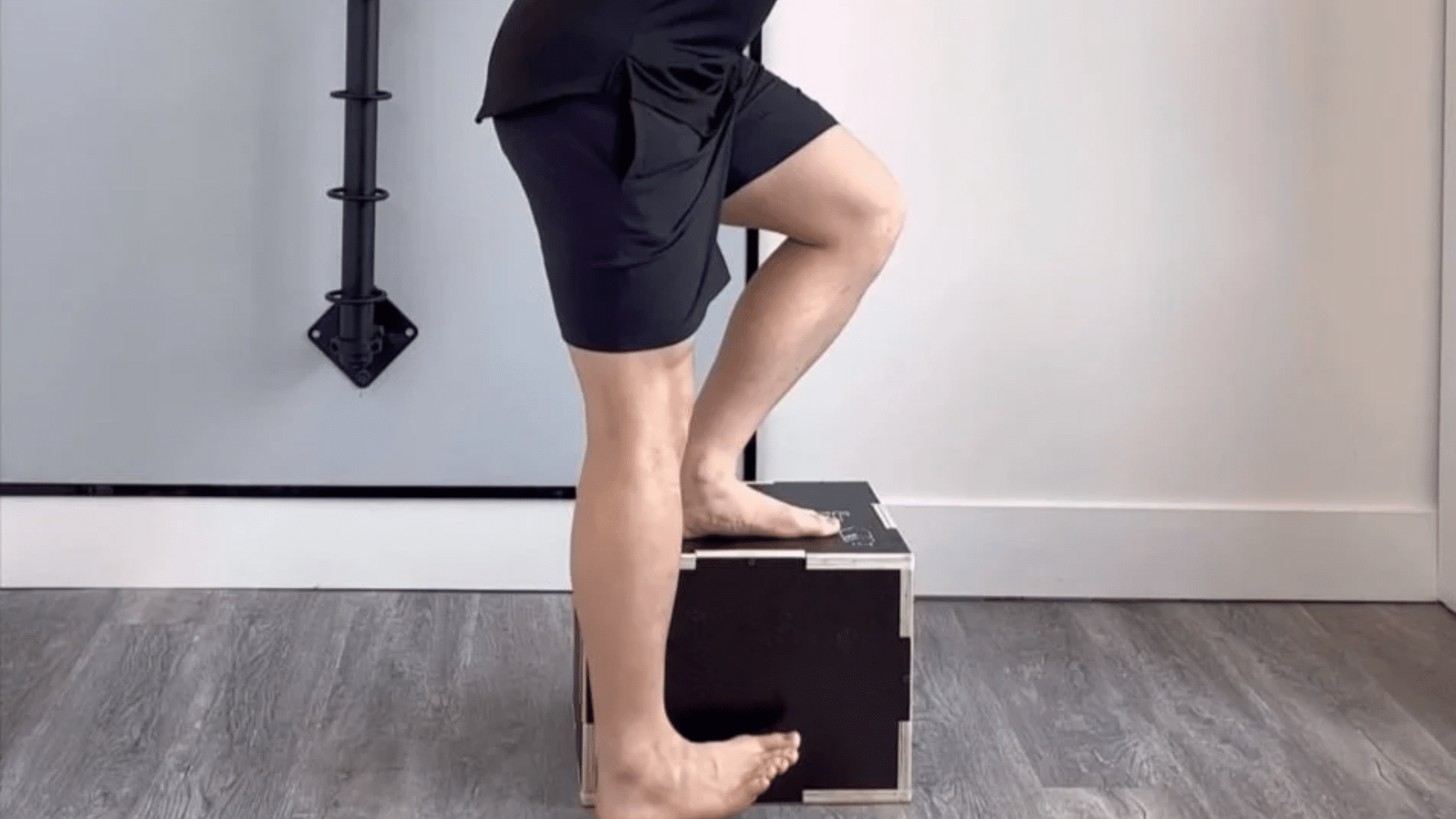
Key focus: Builds quad control and stability by slowing the lowering phase.
How to Do It: Stand on one leg on a low box or step. Slowly bend your knee and lower your other foot toward the floor over 3–5 seconds. Return to the start without collapsing.
Benefits:
- Strengthens quads while protecting knees
- Improves balance and joint control
- Easy to scale for beginners or rehab
Tips:
- Keep knees aligned with toes
- Start with a low step height
- Move slowly to maximize results
Progression Table:
| Level | Variation |
|---|---|
| Beginner | Step down from a 4–6 inch step |
| Intermediate | Decline step-down |
| Advanced | Weighted step-down with dumbbells |
Quick Fix for Mistake: Count “one-two-three” as you lower to control tempo.
2. Eccentric Lunge
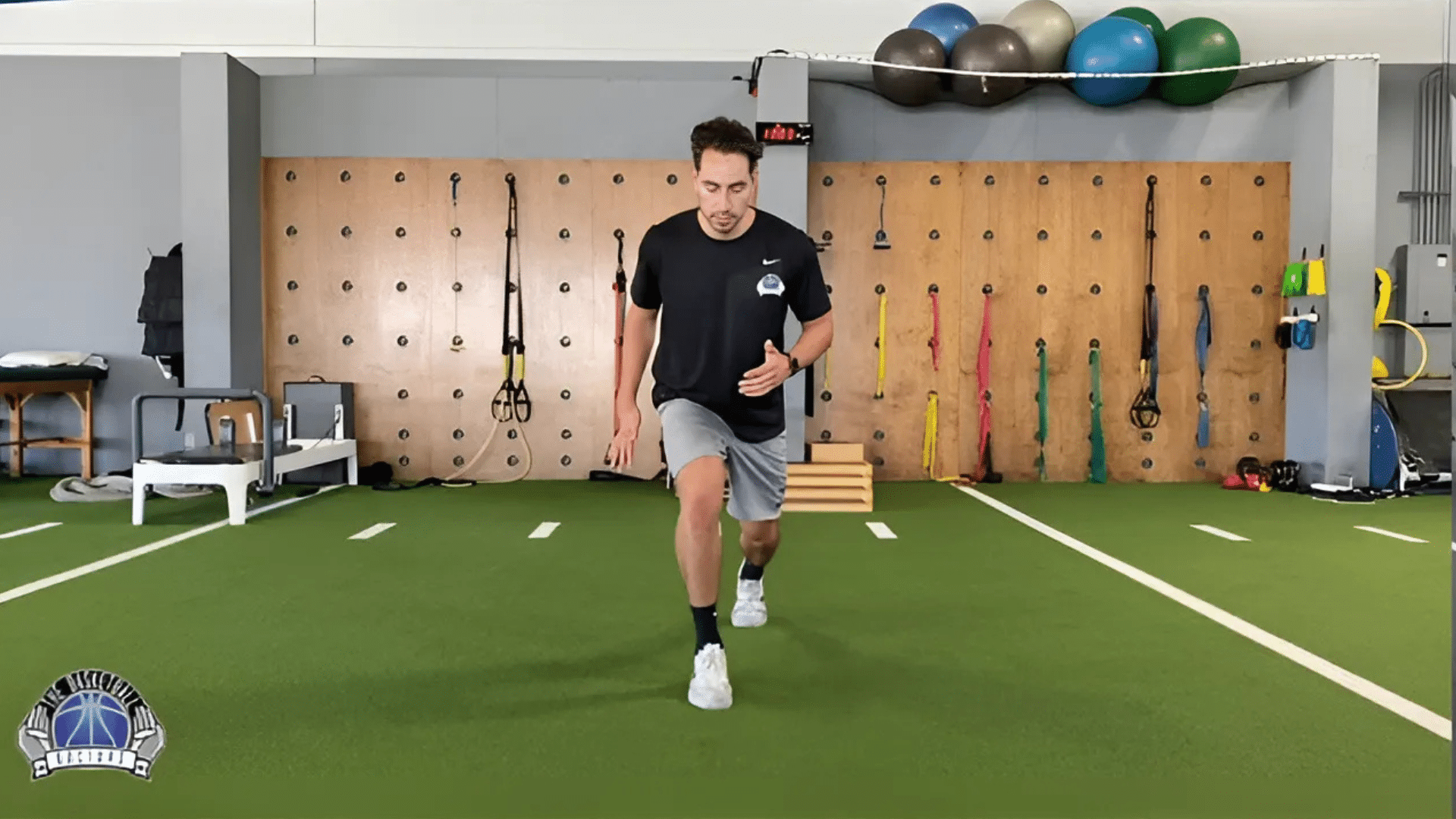
Key focus: Slow descent builds quad strength and stability while stretching hip flexors.
How to Do It: Step one foot forward and lower into a lunge over 3–5 seconds. Keep your torso upright. Push back up quickly to start.
Benefits:
- Mimics sport-specific movements
- Strengthens and stabilizes the front leg
- Improves hip flexibility and balance
Tips:
- Avoid rushing the lowering phase
- Keep your torso straight
- Adjust step length for comfort
Progression Table:
| Level | Variation |
|---|---|
| Beginner | Bodyweight eccentric lunge |
| Intermediate | Weighted eccentric lunge |
| Advanced | Walking eccentric lunges with dumbbells |
Quick Fix: Film yourself to check posture and knee alignment.
3. Reverse Nordic Curl
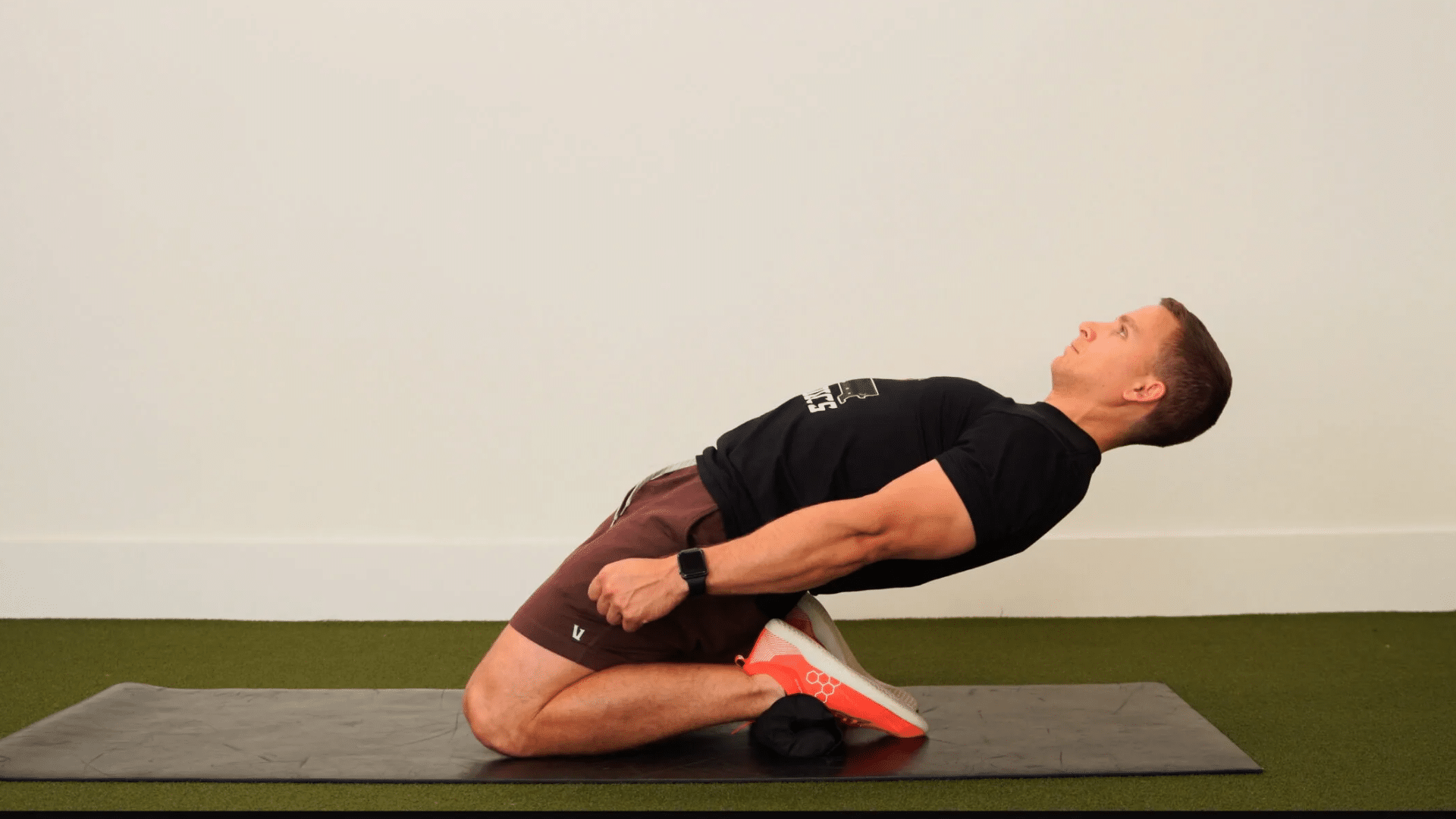
Key focus: Strengthens quads and tendons by resisting gravity from a kneeling position.
How to Do It: Kneel with feet anchored and lean backward, keeping your body straight. Lower slowly, then return to upright.
Benefits:
- Improves tendon health and knee resilience
- Builds durability in lengthened quads
- Excellent for athletes and rehab patients
Tips:
- Start with a small range if new
- Squeeze glutes to stay straight
- Move slowly to reduce strain
Progression Table:
| Level | Variation |
|---|---|
| Beginner | Partial reverse Nordic curl |
| Intermediate | Full reverse Nordic curl |
| Advanced | Weighted reverse Nordic curl |
Quick Fix: Place a cushion under your knees for comfort and stability.
4. Single-Leg Eccentric Box Squat
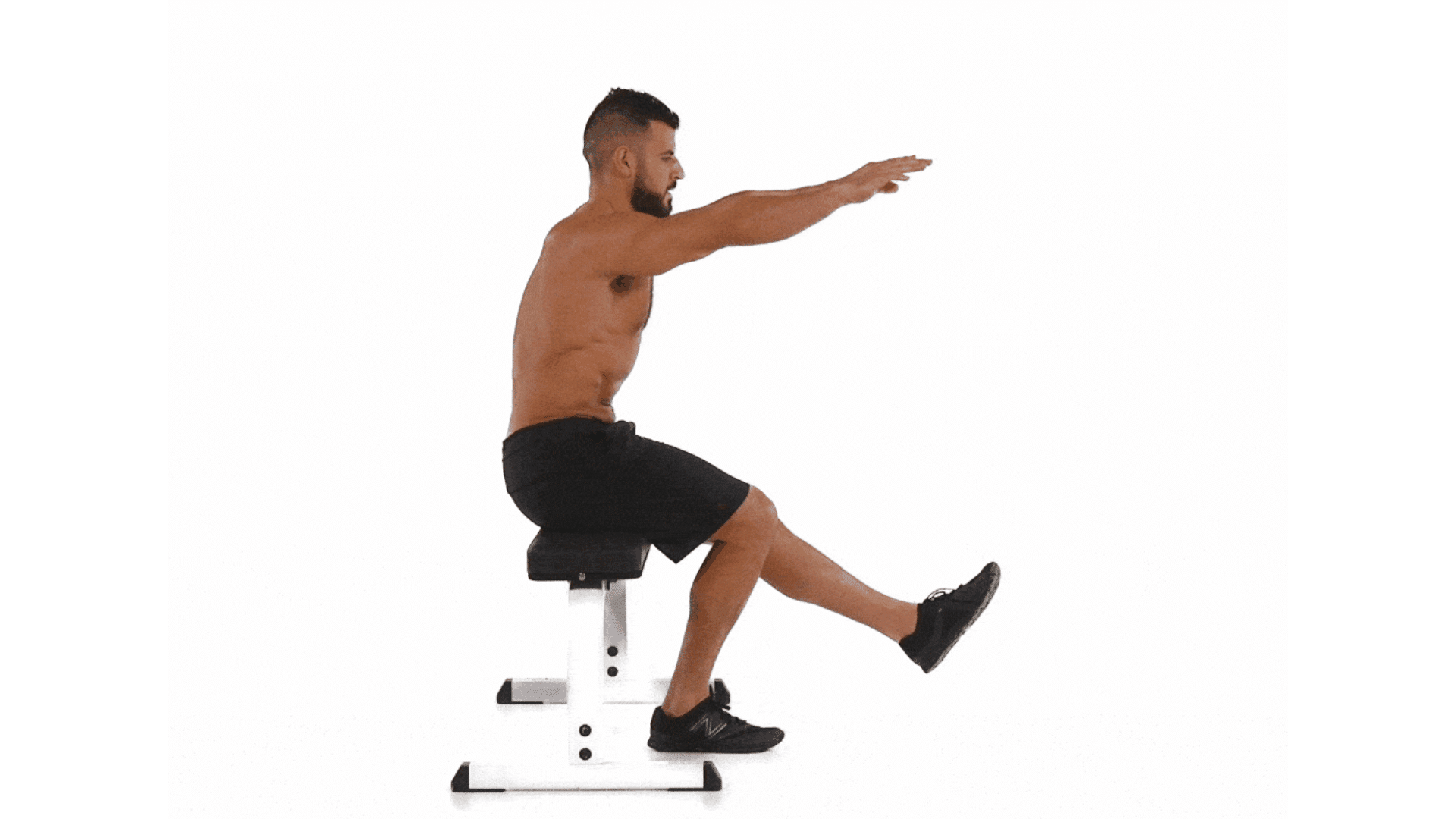
Key focus: Isolates one leg to improve balance, strength, and landing control.
How to Do It: Stand on one leg in front of a box. Slowly sit down under control over 3–5 seconds. Return to standing.
Benefits:
- Strengthens quads, glutes, and stabilizers
- Reveals imbalances between sides
- Builds safer knee mechanics
Tips:
- Don’t “drop” onto the box
- Keep chest tall and core tight
- Lower box height to scale
Progression Table:
| Level | Variation |
|---|---|
| Beginner | Assisted single-leg box squat |
| Intermediate | Bodyweight single-leg box squat |
| Advanced | Weighted single-leg box squat |
Quick Fix: Use a mirror to check knee tracking.
5. Eccentric Leg Extension (Machine or Band)

Key focus: Isolates quads under eccentric tension without balance demands.
How to Do It: Extend both legs to lift the weight, then lower slowly with one leg. Control the descent.
Benefits:
- Builds quad size and tendon strength
- Perfect for gym users or rehab
- Easy to adjust load
Tips:
- Choose a manageable weight
- Hold handles for stability
- Lower for at least 3 seconds
Progression Table:
| Level | Variation |
|---|---|
| Beginner | Light band leg extension |
| Intermediate | Machine eccentric leg extension |
| Advanced | Heavier machine eccentric leg extension |
Quick Fix: Start with a lighter weight to focus on form.
6. Split Squat / Bulgarian Split Squat
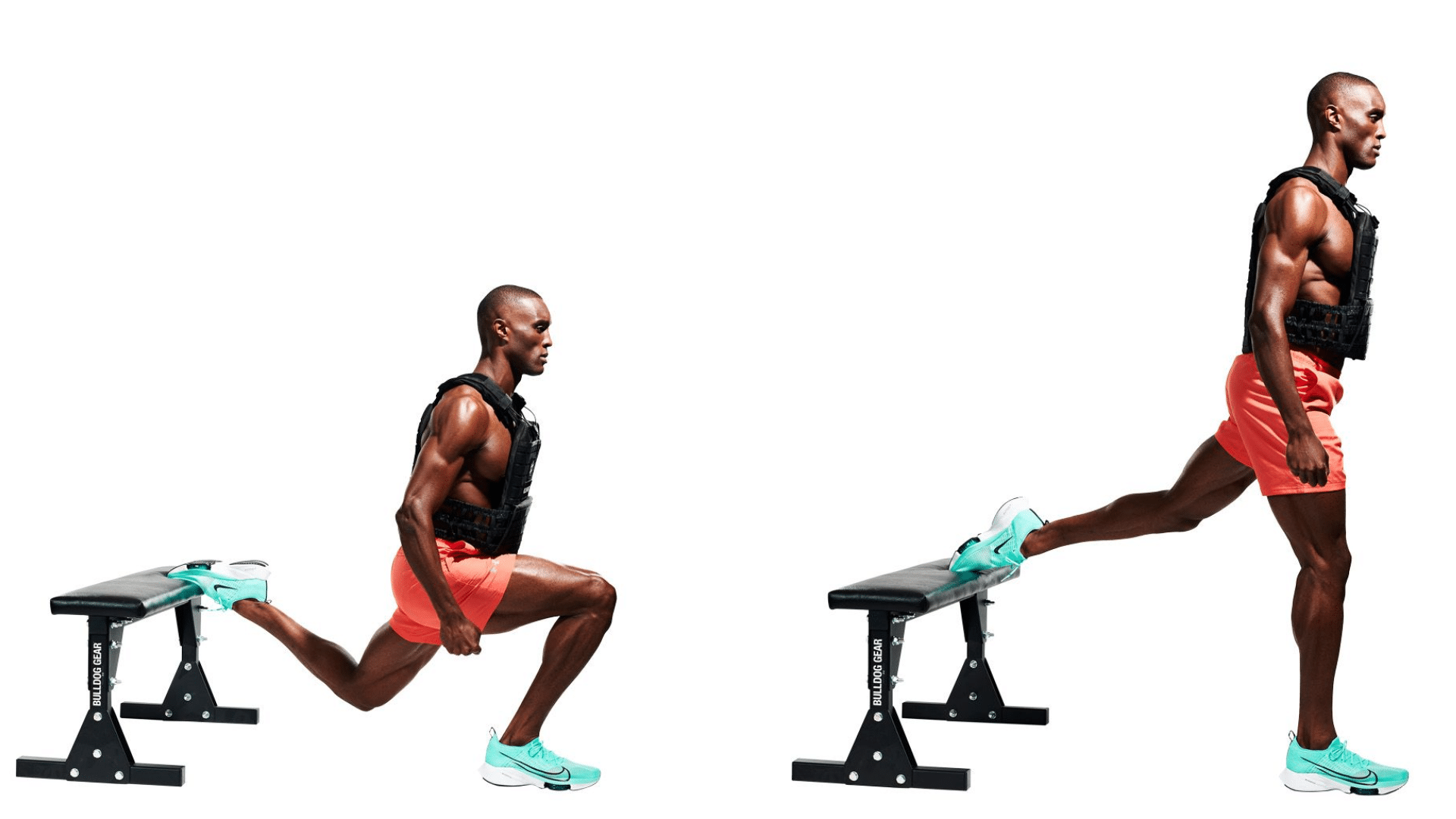
Key focus: Slow lowering of the back knee emphasizes front-leg quads for strength and stability.
How to Do It: Place your back foot on a bench. Lower your back knee slowly toward the ground while keeping balance. Stand back up.
Benefits:
- Improves single-leg strength
- Enhances joint stability
- Works well for athletes and runners
Tips:
- Start with bodyweight
- Keep the front knee aligned with the toes
- Hold weights for added difficulty
Progression Table:
| Level | Variation |
|---|---|
| Beginner | Bodyweight Bulgarian split squat |
| Intermediate | Bulgarian split squat with dumbbells |
| Advanced | Bulgarian split squat with barbell |
Quick Fix: Keep front knee aligned with toes and chest upright.
7. Spanish Squat

Key focus: Band support allows upright posture and joint-friendly quad loading.
How to Do It: Anchor a band behind your knees. Lean back and squat down slowly, keeping your torso upright. Return to standing.
Benefits:
- Strengthens quads and tendons with less strain
- Great for knee pain and rehab
- Encourages proper posture
Tips:
- Keep weight in heels
- Don’t tip forward
- Adjust band tension for comfort
Progression Table:
| Level | Variation |
|---|---|
| Beginner | Band anchored behind knees, partial squat |
| Intermediate | Full-depth Spanish squat |
| Advanced | Weighted Spanish squat (hold plate or dumbbell) |
Quick Fix: Keep weight in heels and avoid tipping forward.
8. Pistol Squat (Advanced)

Key focus: The one-leg squat with a slow descent targets the quads intensely and challenges balance.
How to Do It: Stand on one leg with the other extended forward. Lower slowly under control, then stand up.
Benefits:
- Builds serious strength and control
- Improves hip and ankle mobility
- Advanced bodyweight training goal
Tips:
- Practice on a box for assistance
- Use a support if needed
- Move gradually to full depth
Progression Table:
| Level | Variation |
|---|---|
| Beginner | Assisted pistol squat to box |
| Intermediate | Full pistol squat to box |
| Advanced | Unassisted full pistol squat |
Quick Fix: Hold onto a support until you build enough control.
9. Wall Sit with Slow Slide (Beginner)
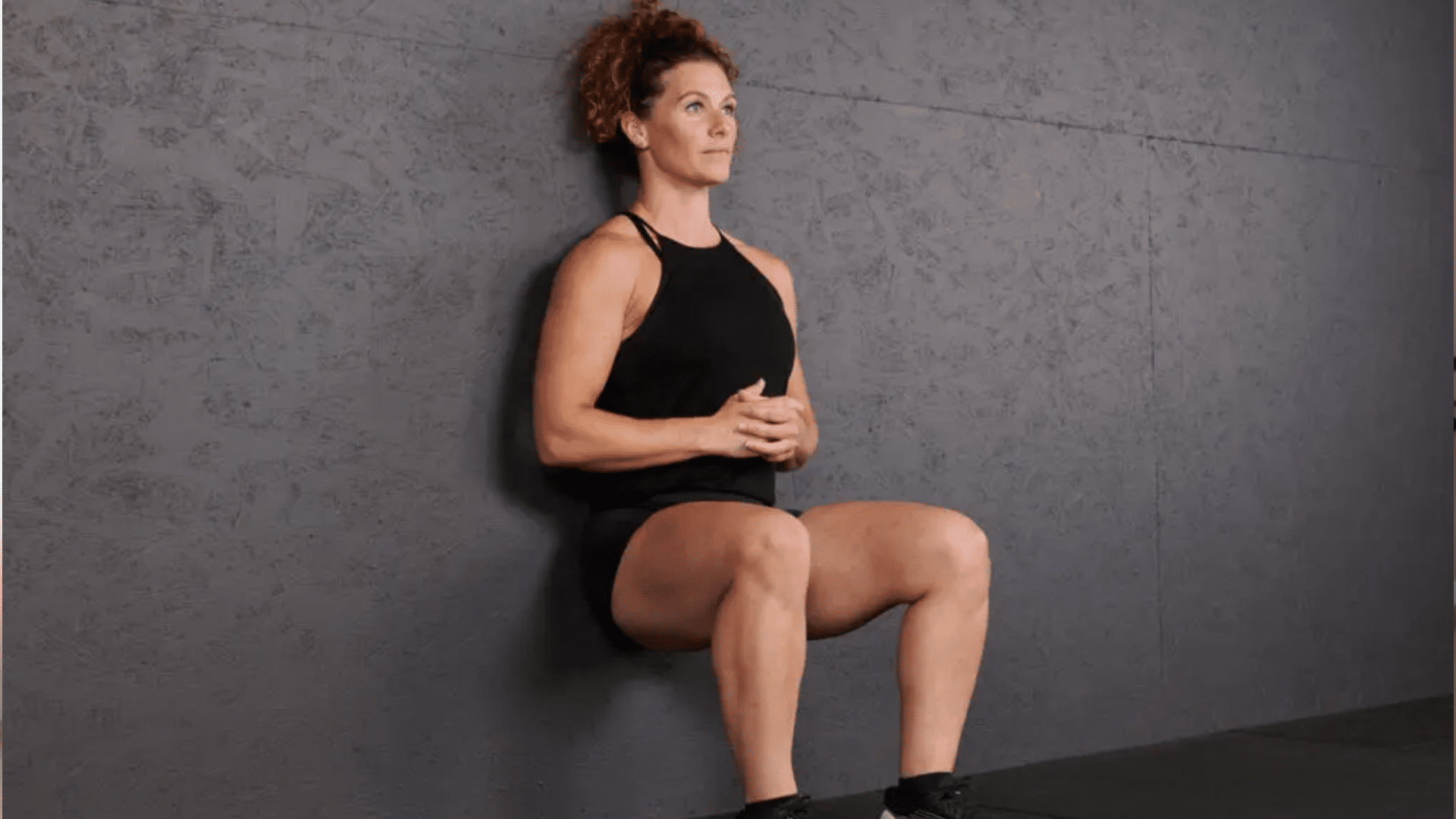
Key focus: Builds quad endurance and control without extra load.
How to Do It: Stand against a wall, feet forward. Slide down slowly into a seated position over 5–7 seconds. Pause, then return up.
Benefits:
- Low-impact quad training
- Improves endurance and stability
- Perfect for beginners or older adults
Tips:
- Keep knees at 90 degrees or higher
- Maintain flat back contact
- Increase hold time as you improve
Progression Table:
| Level | Variation |
|---|---|
| Beginner | Short hold (10–15 seconds) |
| Intermediate | Full 20–30 second hold |
| Advanced | Add a weight plate to lap for hold |
Quick Fix: Keep knees at 90 degrees and back flat against the wall.
10. Decline Step-Down (Intermediate)
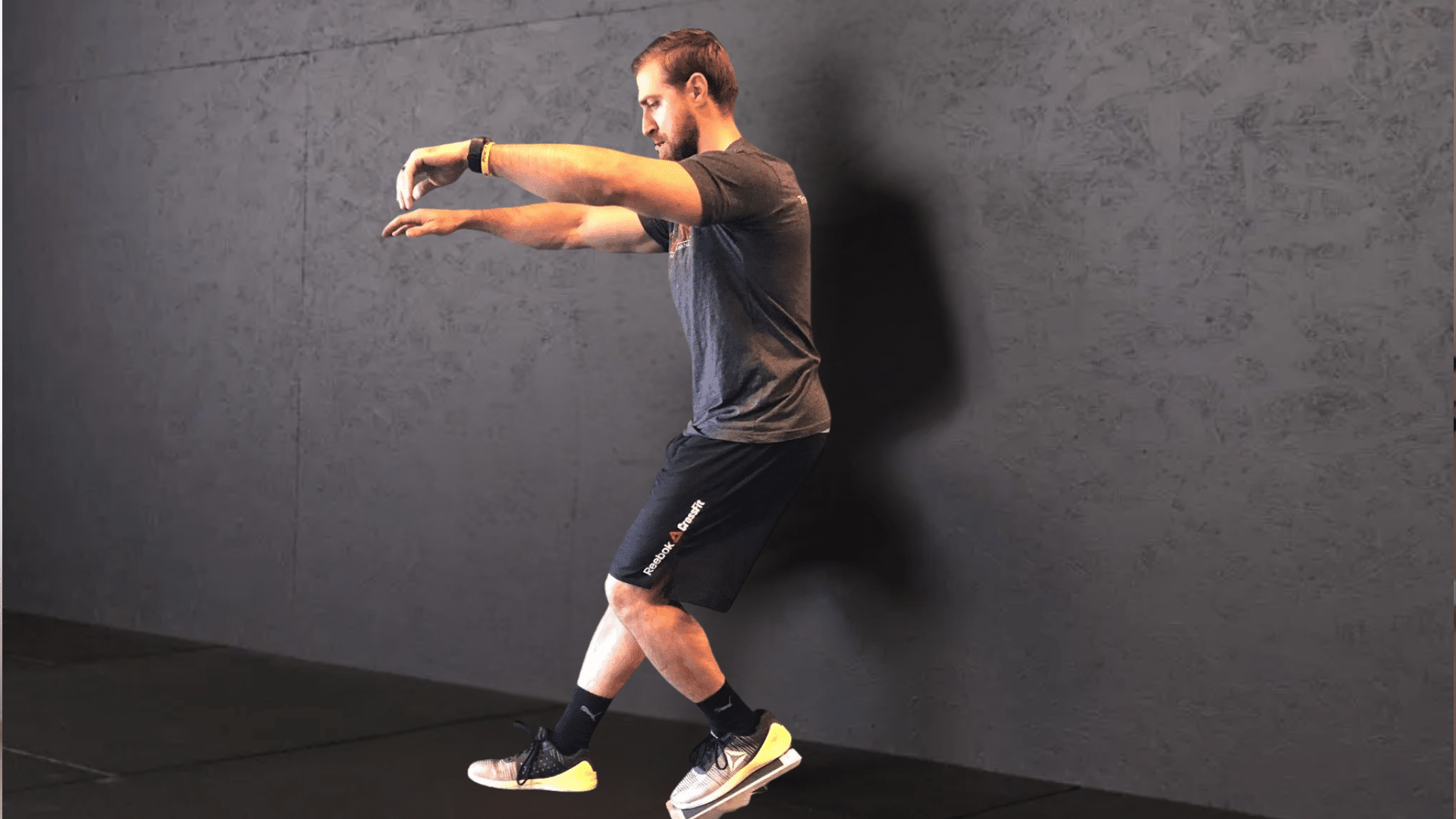
Key focus: Extra eccentric load on quads, ideal for patellar tendon rehab.
How to Do It: Stand on a decline board or wedge. Step down slowly with one leg, keeping the knee aligned with the toes.
Benefits:
- Targets quads more intensely
- Helps reduce tendon pain
- Great progression for athletes
Tips:
- Use a railing for balance
- Start with a small decline
- Control descent for 3–5 seconds
Progression Table:
| Level | Variation |
|---|---|
| Beginner | Step down from a small decline |
| Intermediate | Step down from moderate decline |
| Advanced | Weighted step-down from decline |
Quick Fix: Use a railing for balance and control knee alignment.
11. Tempo Goblet Squat (Beginner–Intermediate)

Key focus: Added weight and slow descent increase time under tension.
How to Do It: Hold a dumbbell at your chest. Squat down for over 4–5 seconds, then stand up quickly.
Benefits:
- Builds quad strength and awareness
- Bridges the gap to heavier lifts
- Improves form under load
Tips:
- Keep chest up
- Don’t let knees cave inward
- Choose a manageable weight
Progression Table:
| Level | Variation |
|---|---|
| Beginner | Bodyweight slow squat |
| Intermediate | Goblet squat with light dumbbell |
| Advanced | Heavier goblet squat with longer tempo (5–6 sec) |
Quick Fix: Keep your chest up and avoid your knees caving inward.
12. Eccentric Leg Press (Intermediate)
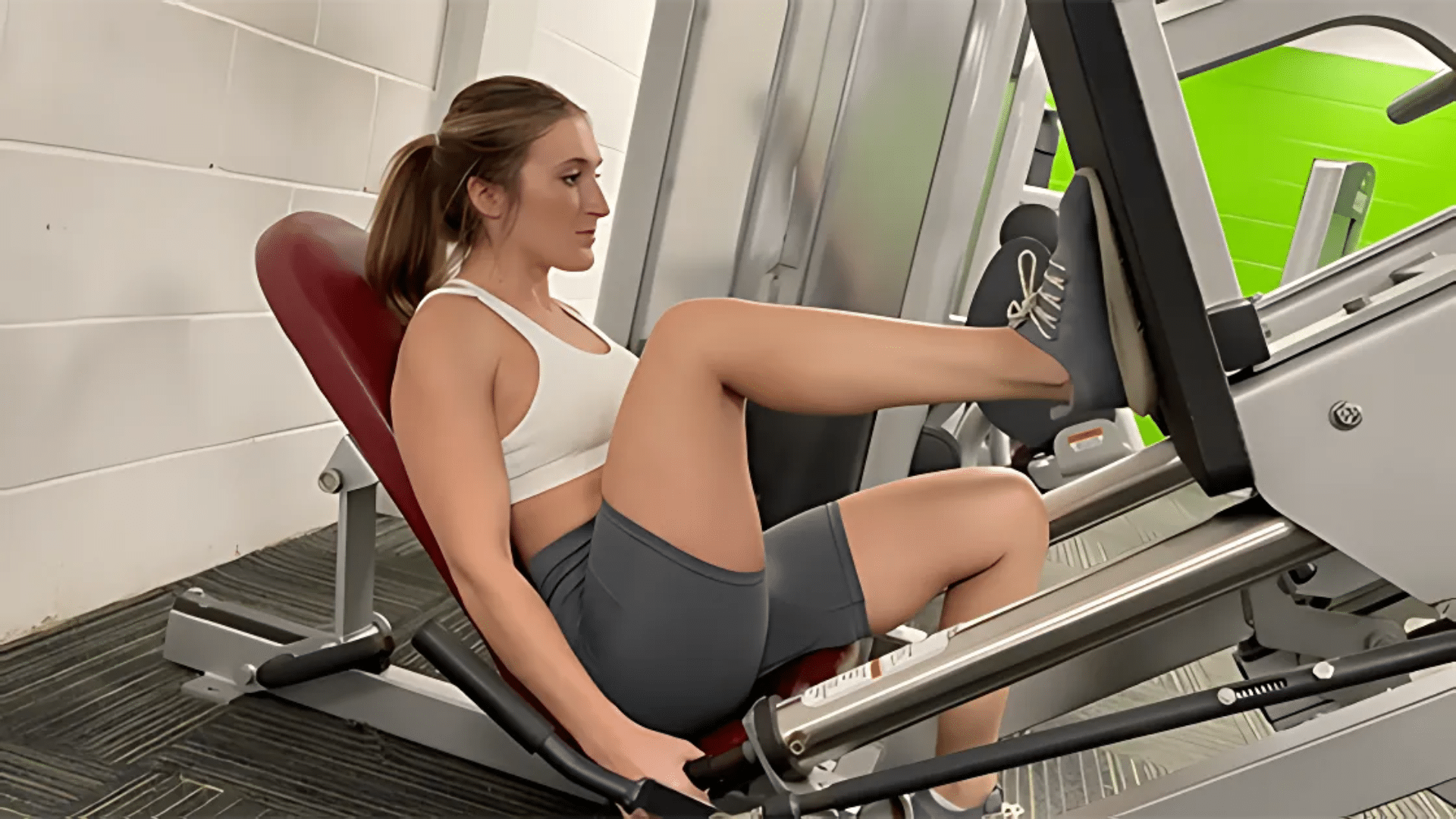
Key focus: Heavy eccentric quad loading with minimal balance demand.
How to Do It: Push the weight up with both legs, then lower slowly with one leg over 3–5 seconds.
Benefits:
- Adds a heavier load safely
- Builds power and control
- Ideal for rehab or progressive strength
Tips:
- Keep feet flat
- Don’t lock knees at the top
- Control the entire lowering phase
Progression Table:
| Level | Variation |
|---|---|
| Beginner | Lightweight both legs down |
| Intermediate | Moderate weight, one-leg lowering |
| Advanced | Heavyweight, slow one-leg lowering |
Quick Fix: Don’t lock your knees at the top; control the entire lowering phase.
13. Slow Lateral Step-Down (Beginner–Intermediate)

Key focus: Targets quads and hip stabilizers by stepping sideways off a step slowly.
How to Do It: Stand sideways on a step. Slowly lower one foot to the ground over 3–5 seconds, keeping control.
Benefits:
- Builds lateral knee stability
- Improves quad control
- Prepares legs for a change of direction
Tips:
- Hold onto support for balance
- Start with a low step height
- Keep your hips level throughout
Progression Table:
| Level | Variation |
|---|---|
| Beginner | Low box step-up with slow lower |
| Intermediate | Higher box step-up with slow lower |
| Advanced | Weighted step-up with slow lower |
Quick Fix: Keep knees aligned with toes and start with a low box.
14. Heel-Elevated Eccentric Squat
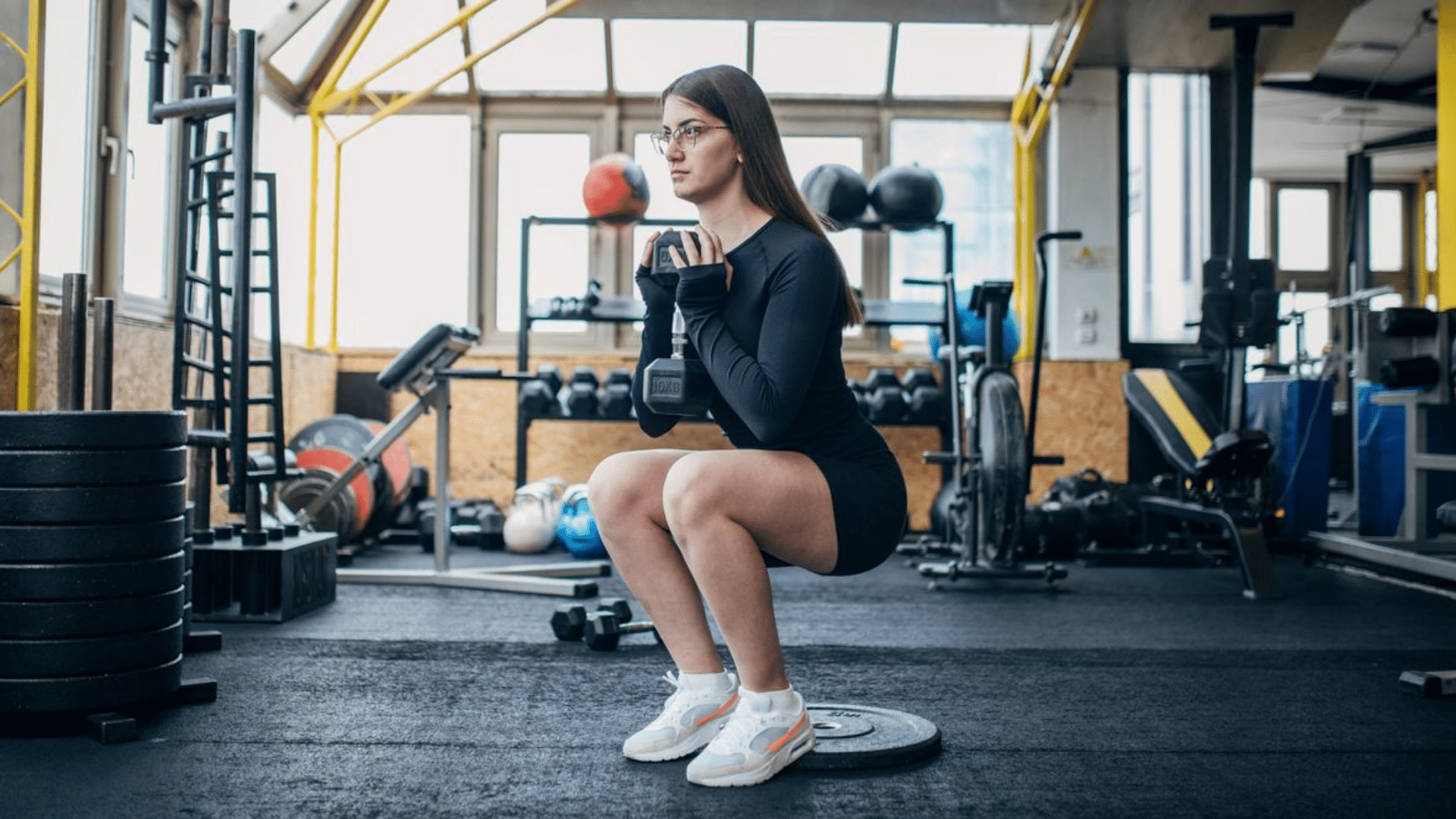
Key focus: Elevating heels shifts more load to the quads and deepens the eccentric phase.
How to Do It: Stand on small plates or a slant board with heels raised. Lower slowly for 4–5 seconds, then stand up.
Benefits:
- Targets quads more directly
- Great for tendon rehab
- Improves ankle mobility
Tips:
- Keep heels stable
- Maintain an upright torso
- Don’t bounce at the bottom
Progression Table:
| Level | Variation |
|---|---|
| Beginner | Bodyweight heel-elevated squat |
| Intermediate | Light dumbbell heel-elevated squat |
| Advanced | Heavy dumbbell heel-elevated squat with 5–6 sec descent |
Quick Fix: Lower slowly and don’t shift weight back onto toes.
15. Reverse Sled Drag

Key focus: Walking backward under load eccentrically strengthens quads with low impact.
How to Do It: Attach a sled or weight, grab straps, and walk backward slowly with small steps, knees bent slightly.
Benefits:
- Builds quad endurance and control
- Joint-friendly knee training
- Great conditioning tool
Tips:
- Start with a light load
- Keep torso upright
- Focus on slow, steady steps
Progression Table:
| Level | Variation |
|---|---|
| Beginner | Bodyweight backward walk |
| Intermediate | Light sled drag backward |
| Advanced | Heavy sled drag backward with slow tempo |
Quick Fix: Keep knees soft and avoid jerky movements.
16. Slow Step-Through Lunge
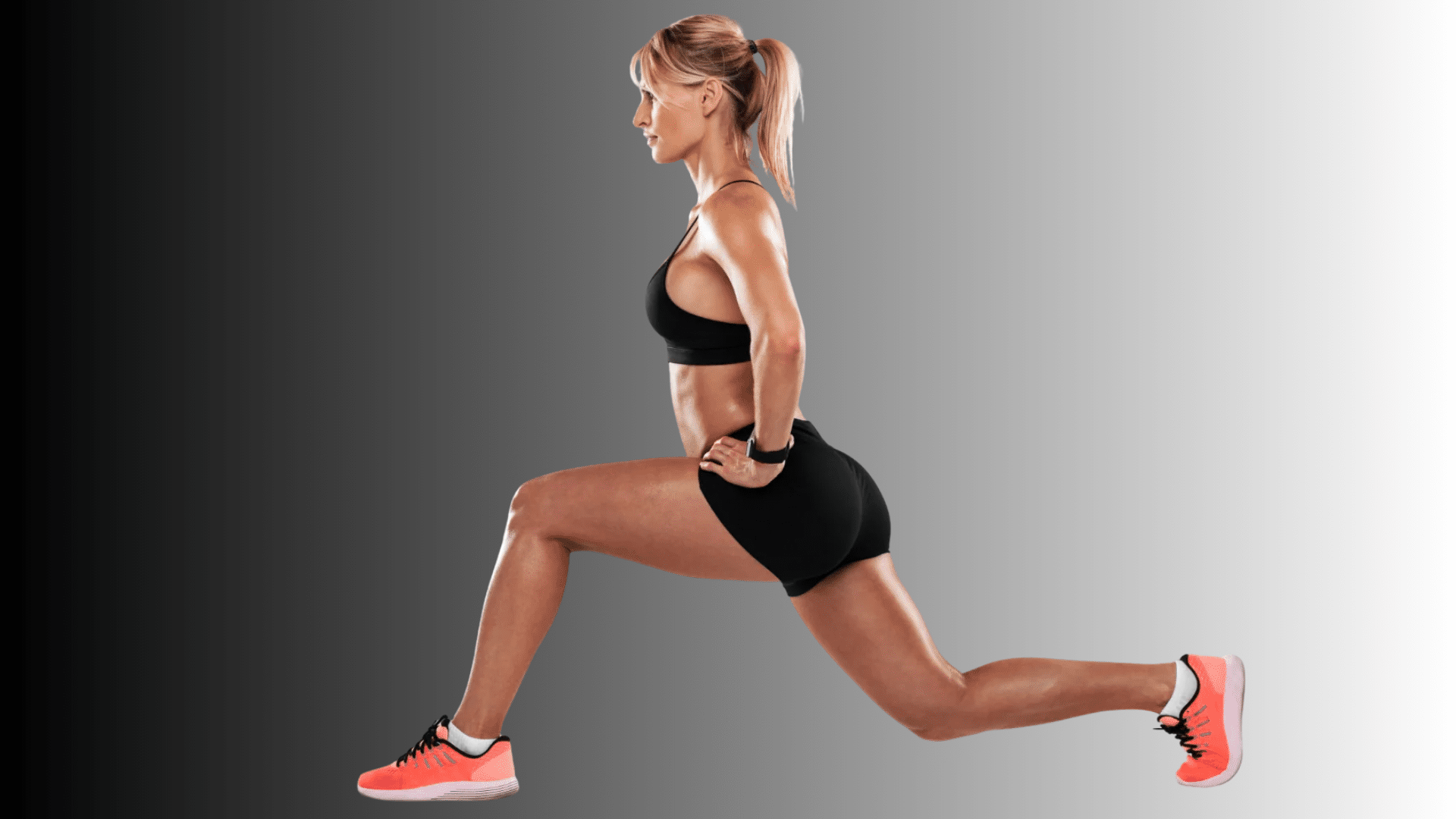
Key focus: Combines forward and backward lunges with controlled lowering.
How to Do It: Step into a forward lunge, lower over 3–5 seconds, then step through into a reverse lunge with the same leg.
Benefits:
- Improves single-leg stability
- Builds eccentric control
- Mimics athletic movements
Tips:
- Maintain upright posture
- Keep knees aligned
- Use bodyweight before load
Progression Table:
| Level | Variation |
|---|---|
| Beginner | Bodyweight slow step-through lunge |
| Intermediate | Weighted slow step-through lunge |
| Advanced | Step-through lunge with a longer 5–6 sec descent |
Quick Fix: Slow your transitions to avoid losing balance.
17. Slant Board Split Squat

Key focus: Elevating the front foot on a slant board amplifies quad demand eccentrically.
How to Do It: Place your front foot on a slant board. Lower your back knee slowly over 4–5 seconds, then return to the start.
Benefits:
- Maximizes quad activation
- Builds knee-friendly strength
- Enhances flexibility in the hips and ankles
Tips:
- Keep torso upright
- Don’t rush the descent
- Start with low slant angle
Progression Table:
| Level | Variation |
|---|---|
| Beginner | Bodyweight slant board split squat |
| Intermediate | Light dumbbell slant board split squat |
| Advanced | Heavy dumbbell slant board split squat with 5–6 sec descent |
Quick Fix: Watch your front knee; it should track over your toes, not collapse inward.
18. Slow Step-Down with Pause
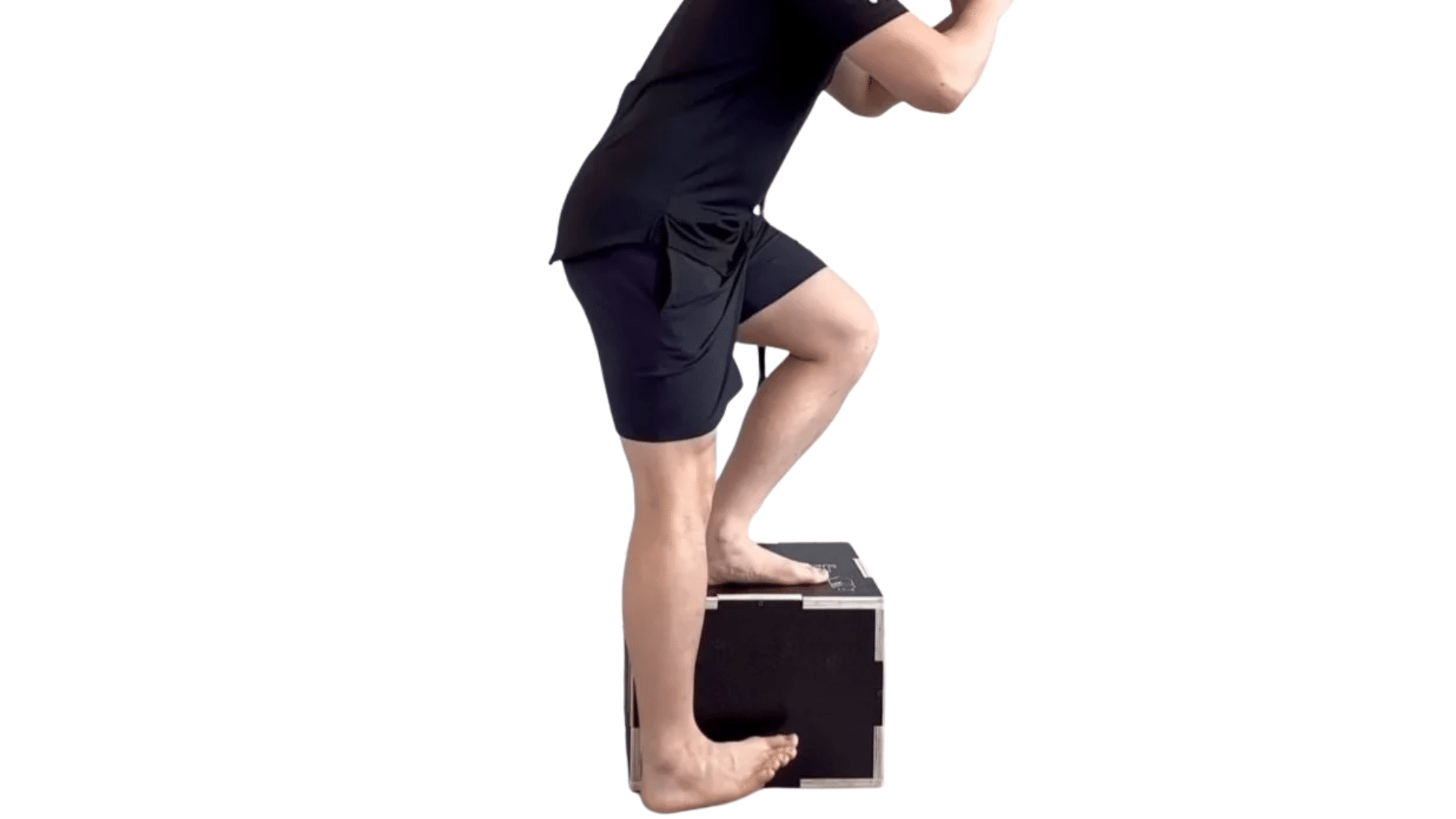
Key focus: Adding a pause at the bottom increases time under tension.
How to Do It: Stand on a step. Lower your foot to the ground over 3–5 seconds, pause for 1–2 seconds, then return up.
Benefits:
- Builds eccentric control
- Improves balance at low range
- Increases quad endurance
Tips:
- Start with a low height
- Keep chest up
- Use support if needed
Progression Table:
| Level | Variation |
|---|---|
| Beginner | Short step-down with pause |
| Intermediate | Higher step-down with pause |
| Advanced | Weighted step-down with pause |
Quick Fix: Don’t skip the pause; it reinforces control.
19. Assisted Sissy Squat

Key focus: Deep eccentric quad loading with minimal hip involvement.
How to Do It: Hold onto a support. Lean back as you bend your knees, lowering slowly while keeping your hips extended.
Benefits:
- Intense quad isolation
- Builds tendon resilience
- Advanced bodyweight option
Tips:
- Hold onto a sturdy object
- Keep hips pushed forward
- Move slowly to reduce knee stress
Progression Table:
| Level | Variation |
|---|---|
| Beginner | Partial assisted sissy squat |
| Intermediate | Full assisted sissy squat |
| Advanced | Weighted sissy squat |
Quick Fix: Only go as low as you can control without pain.
20. Eccentric Step-Up with Knee Drive
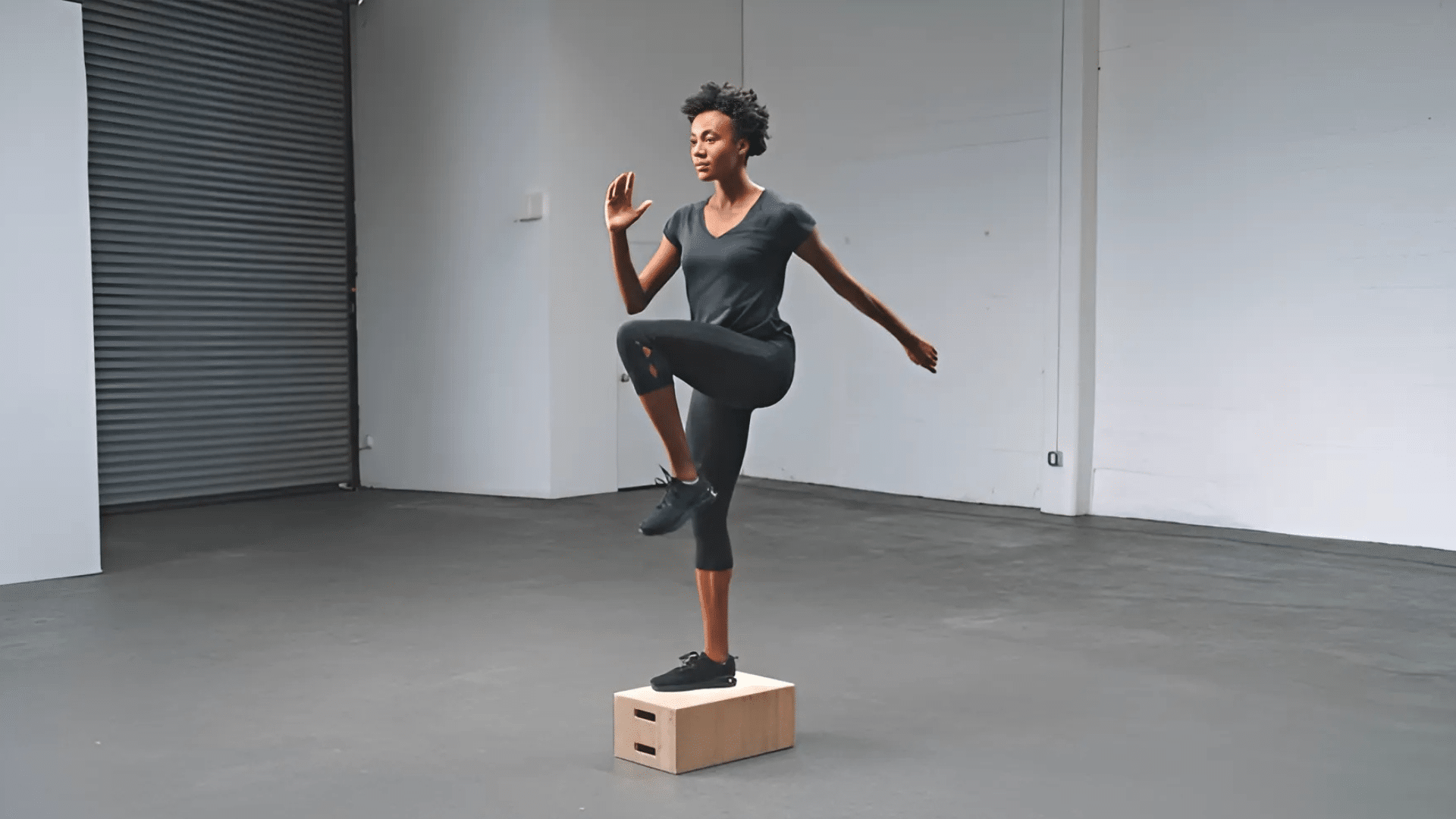
Key focus: Slow upward step plus knee drive challenges quads eccentrically and builds balance.
How to Do It: Step onto a box with one leg while driving the opposite knee up. Lower back down slowly over 3–5 seconds to the start.
Benefits:
- Builds single-leg quad control
- Improves coordination and stability
- Adds a dynamic element for athletes
Tips:
- Start with a low box
- Keep torso upright
- Use bodyweight first, then add dumbbells
Progression Table:
| Level | Variation |
|---|---|
| Beginner | Bodyweight slow step-up with knee drive |
| Intermediate | Dumbbell step-up with slow knee drive |
| Advanced | Weighted step-up with slow knee drive and longer descent |
Quick Fix: Focus on controlling the lowering phase, don’t “drop” off the box.
How to Program Eccentric Quad Workouts
To get the most from eccentric quad training, you need the right structure. Here’s how you can plan your workouts to build strength safely and effectively:
Programming Guidance (Sets, Reps, Weekly Frequency, Tempo)
For eccentric quad training, perform 3–4 sets of 6–8 slow reps, two to three times weekly. Lower for 3–5 seconds, then return to the start quickly. Rest between sets allows recovery without fatigue.
Focus on quality over quantity, keeping movements controlled and consistent. Gradual progression ensures results while minimizing strain, making this method safe for beginners, athletes, and those recovering from injury.
Equipment Options (Bands, Dumbbells, Machines, or Bodyweight-only)
You can adapt eccentric quad workouts with different tools. Resistance bands add joint-friendly tension, dumbbells provide adjustable load, and machines give controlled paths.
For simplicity, bodyweight exercises work well, especially for beginners or rehab. Mixing tools prevents monotony and matches goals. Bands or bodyweight are best for recovery, while weighted options are ideal for strength building.
Choose equipment based on fitness level, access, and training purpose.
Progressions & Levels (Beginner → Intermediate → Advanced)
Begin with bodyweight basics like step-downs or Spanish squats. As strength improves, move to single-leg variations and weighted squats. Intermediate lifters can use bands or dumbbells to increase resistance and challenge balance.
Advanced athletes should aim for high-control moves like pistol squats or heavy eccentric lunges. Progress gradually, focusing on control and form at each stage. This approach builds safe, lasting strength without overloading joints too soon.
Eccentric Quads for Specific Needs
Eccentric quad training can be adapted for various goals and situations, making it useful for different groups. For knee pain or tendonitis, slow controlled lowering strengthens tendons while reducing irritation.
Runners benefit from added durability during downhill running, where quads must absorb repeated impact. Older adults or post-surgery patients can use low-impact versions, such as Spanish squats or assisted step-downs, to rebuild strength safely.
Athletes gain power and stability for sudden stops, jumps, and landings. By tailoring exercises to the individual, eccentric training supports recovery, performance, and long-term joint health, proving valuable for almost every fitness level.
Common Mistakes to Avoid While Training Eccentric Quads
Avoiding common errors keeps eccentric quad training safe, effective, and supportive of long-term progress without unnecessary strain.
- Moving too fast on the descent: Rushing lowers the effectiveness and increases injury risk. Focus on slow, controlled movements lasting at least three to five seconds.
- Poor posture or knee collapse: Allowing knees to cave inward or lose upright posture stresses joints. Keep knees aligned with toes and chest tall throughout.
- Overloading too early: Using heavy weights too soon strains quads and joints. Start light, master form, and increase resistance gradually as control improves.
Science-Backed Insights on Eccentric Quad Training
Eccentric quad training is supported by strong scientific evidence, showing benefits that go beyond traditional strength exercises. Research highlights improvements in muscle size, tendon health, and functional performance when focusing on controlled lowering movements.
Studies from the NIH and clinical trials confirm that eccentric work improves quadriceps strength, reduces knee pain, and speeds up recovery after surgery or injury.
Athletes also gain measurable improvements in jumping ability, stability, and overall performance.
These findings prove that eccentric training is not only effective but essential for long-term joint protection, injury prevention, and building durable lower-body strength.
Conclusion
If you’ve ever felt your quads burning on stairs, hills, or tough workouts, you know why eccentric training matters.
I’ve seen how focusing on the lowering phase builds not just muscle but lasting resilience in my own training. Now it’s your turn, try adding a few of these eccentric quad exercises into your week and notice how your legs respond.
Stronger quads mean more control, fewer injuries, and better performance in everything you do. If this breakdown helped you, take the next step and check out other exercise guides on the website for more ways to strengthen your body!

